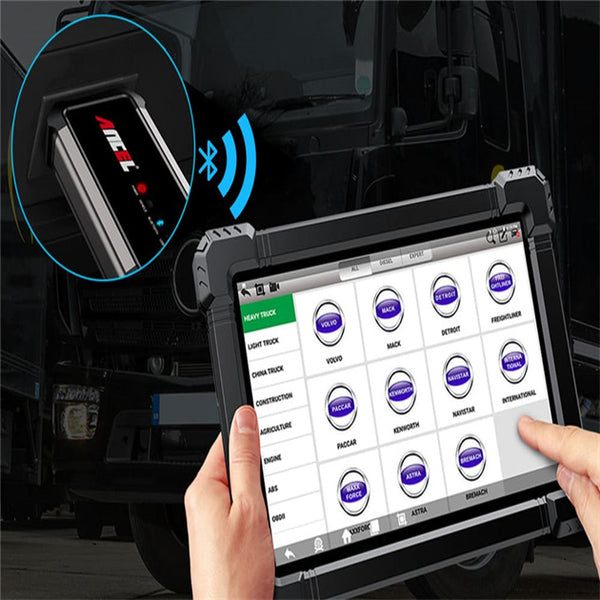FORD fault codes, often displayed as a series of numbers and letters through your vehicle’s dashboard, car scanner tool that help identify specific issues within your vehicle's systems.
We will help you understand what each code means and how to address it effectively.
How to Read Ford Fault Codes
Ford vehicles are equipped with an On-Board Diagnostics system that monitors and reports on the various systems within the vehicle.
When a system fails or a parameter is out of normal range, the OBD2 system records a fault code and, in many cases, triggers the "Check Engine" light on the dashboard. These fault codes are known as Diagnostic Trouble Codes.
Reading Ford fault codes is straightforward with the use of an OBD-II scanner, which can be connected to your vehicle’s OBD port, usually found under the dashboard.
Once connected, the scanner displays the fault code(s) stored in the system.
These codes typically begin with a letter followed by four digits, for example, P0301.
- P codes signify issues related to the powertrain, which includes the engine, transmission, and associated systems.
- B codes indicate problems with the body systems, such as power windows or airbags.
- C codes are related to the chassis, covering systems like anti-lock brakes and steering.
- U codes indicate data communication errors across the vehicle’s network.
Related Reading: How to Read Code on Car
Common Ford Fault Codes and Their Solutions
P0300 - Random/Multiple Cylinder Misfire Detected:
This code suggests that multiple engine cylinders are misfiring, leading to engine shaking and reduced power.
Possible causes include faulty spark plugs, ignition coils, or fuel delivery issues.
P0171 - System Too Lean (Bank 1):
This indicates that the air-to-fuel ratio in the engine is too lean, meaning there is too much air and too little fuel.
Check for vacuum leaks, faulty fuel injectors, or a dirty mass airflow sensor.
P0420 - Catalyst System Efficiency Below Threshold (Bank 1): This code often signals a problem with the catalytic converter, which may not be processing exhaust gases efficiently.
Potential fixes include replacing the catalytic converter or checking for exhaust leaks ahead of it.
For more Ford code error meanings, click here to check!
Troubleshooting Tips for Ford Fault Codes
Troubleshooting Ford fault codes involves a systematic approach to diagnosing and resolving issues based on the specific code displayed.
Here are some tips to help you efficiently address and rectify common fault codes:
Tools and Equipment Needed
- OBD2 scanner with bluetooth
- Basic hand tools (e.g., wrenches, screwdrivers)
- Multimeter for electrical testing
- Compression tester for engine issues

Step-by-Step Troubleshooting Process
- Connect the OBD-II Scanner: Plug the scanner into the OBD port and read the fault code.
- Inspect Related Components: Based on the fault code, inspect related components for obvious signs of damage or wear.
- Perform Specific Tests: Use tools like a multimeter or compression tester to diagnose specific systems.
- Repair or Replace Faulty Parts: Depending on the diagnosis, repair or replace damaged components.
- Clear the Fault Codes and Test Drive: Once repairs are made, clear the fault codes with the scanner and take the vehicle for a test drive to ensure that the issue is resolved.
Preventive Maintenance to Avoid Common Ford Fault Codes
Preventive maintenance is key to avoiding many common Ford fault codes.
By keeping up with regular vehicle maintenance, you can prevent issues before they lead to fault codes and potentially costly repairs.
Recommended Maintenance Practices
- Regular Oil Changes: Ensure you change your engine oil and filter at the intervals recommended by Ford to keep the engine running smoothly.
- Check and Replace Spark Plugs: Worn or dirty spark plugs can lead to misfires and poor engine performance. Check and replace them according to Ford’s recommended schedule.
- Air and Fuel Filter Replacement: Regular replacement of air and fuel filters can prevent engine issues related to air and fuel contaminants.

Advanced Diagnostics and Repairs for Complex Ford Fault Codes
Some Ford fault codes may indicate complex issues that require car diagnostic scanner and skilled technicians to resolve.
For these cases, it is often best to consult with a professional mechanic or a Ford dealership.
You could also equip yourself with advanced auto repair tools to diagnose and address complex Ford fault codes effectively.
One such tool is the ANCEL FD700 best professional automotive scanner, designed specifically to detect issues in all Ford system cars.
With the ANCEL FD700 best scanner for cars, you gain the ability to perform advanced diagnostics and pinpoint the source of problems with your vehicle, akin to an auto repair mechanic.
By utilizing advanced diagnostic tools like the ANCEL FD700, you can empower yourself to tackle intricate fault codes and ensure the optimal performance of your Ford vehicle.
Conclusion
By familiarizing yourself with common codes and their meanings, you can diagnose issues early and address them before they escalate.
With this guide, you can keep your Ford running smoothly and avoid costly repairs down the road.
FAQs
Can using a car scanner void my vehicle's warranty?
Merely using a car scanner should not void your vehicle's warranty. However, making unauthorized modifications based on the scanner's diagnostics might impact warranty coverage.
What is the difference between OBD1 and OBD2 scanners?
OBD1 was the early version of onboard diagnostics systems primarily used until the mid-1990s. OBD2 is a standardized system used in cars post-1996 and provides more universal codes and data.
Can I use a car scanner on electric or hybrid vehicles?
Yes, many car scanners can diagnose electric and hybrid vehicles, but it's important to ensure the scanner supports the specific systems and protocols used in these vehicles.















